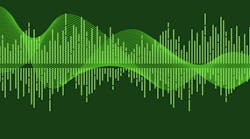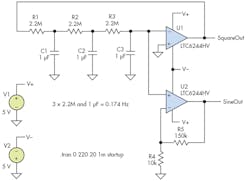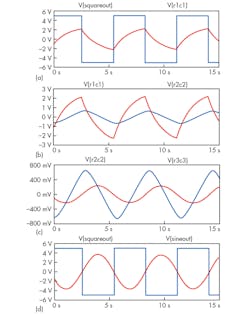Simple Generator Provides Very-Low-Frequency/Distortion Sine and Square Waves
Download this article in PDF format.
The circuit of Figure 1 generates sinusoids down to very low frequencies with distortion in the region of 3% or less, yet has no feedback or gain-stabilizing components because none are needed. It uses a phase-shift oscillator with a low-pass phase-shift network configuration rather than the more-common high-pass network.
The frequency-determining network is used as a low-pass filter to remove most of the harmonic content of the output waveform. Other phase-shift oscillators using low-pass networks have been published, but most have been more complicated (some of them far more so).
1. This very-low-frequency sine- and square-wave generator requires few components, but provides low-distortion outputs (derived from LTspice simulator).
The output of op amp U1 is applied to the first section of the phase-shifting network via R1 and C1. Each stage of the network attenuates more of the harmonic content (along with some of the fundamental). The final sinusoidal waveform is fed back into U1, which is operating open-loop and thus generates square waves at its output. It’s also fed into U2, which is operating as a linear amplifier to restore the low-level sinusoid up to a more-usable level at low impedance.
With three 2.2-MΩ resistors and three 1-µF capacitors, the circuit generates a sinusoid waveform at about 0.174 Hz. (Note that a three-gang variable-tuning capacitor can be used here to create an inexpensive, adjustable-frequency audio oscillator.)
The circuit has a quick startup of a few cycles regardless of frequency, and its output amplitude is very stable. U1 doesn’t need to deliver output rail-to-rail, but it must clip on overload symmetrically; if it does not, then even-order harmonic components will appear in the output. If this circuit also had a true triangular-wave output, it would be called a function generator. However, this simple configuration doesn’t have that output waveform.
By increasing the values of the network components, this circuit can generate sinusoids with periods of the order of a minute or more, which largely depends on the characteristics of the components. With the high resistor values shown, the op amps must be CMOS devices in order to have the necessary extremely high input impedance, and the timing capacitors must also have very low leakage. Figure 2 shows the circuit’s waveforms at critical points.
2. The waveforms at four critical points include the output of U1 (the square wave) and the junction of R1 and C1 (the “triangular” wave) (a); the waveforms at R1/C1 and R2/C2 (b); the waveform at R2/C2 and the sinusoidal waveform at R3/C3 (c); and the square-wave and sine-wave outputs from this simple generator (d).
A possible negative aspect of this circuit is that it requires a second op amp as a buffer with gain to provide the sinewave output. That second op amp has the same high input-impedance requirement as the first one. Although shown as a generator of very low frequencies, the upper-frequency range of this circuit is limited only by the gain-bandwidth product characteristics of the chosen op amps. By using available wideband op amps, it will operate into the upper parts of the audio region without a serious increase in distortion.
Jim Tonne has been involved with electrical-circuit design and analysis, largely in the broadcast industry, since 1965. His specialties are filter design and speech processing, and he has been a regular contributor to the ARRL Handbook as well as QEX, their Forum for Communications Experimenters. His website is www.TonneSoftware.com and can be reached at [email protected].



